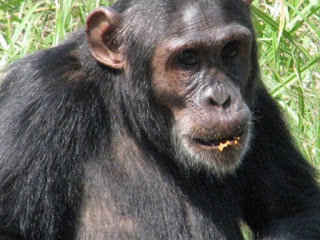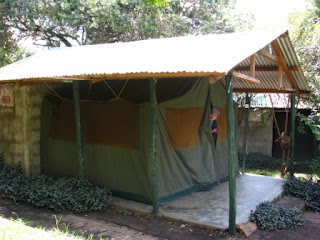Not quite done yet! Our midnight bus was standing room only (seating not as guaranteed as promised). After a ticket refund and a night at a flea bag hotel (even for me), we hired a car for what turned out to be a lovely five and a half hour drive, through a National Park, along rolling hills and all paved (albeit for 10 times the price of the bus – a tough decision especially for me).
The next two days were spent at a lovely “real” eco-resort on Lake Bunyonyi, nestled in the volcanic mountains that form the border between Uganda and Rwanda. This is also nearby to the series of National Parks in both countries that are home to the Mountain Gorillas (the animals have dual citizenship).
 |
| Crowned Crane - National Bird of Uganda |
Our plan was to overland to the Rwanda side and so we hired a car to the border (only about 20 minutes), exchanged some cash, went through the Uganda immigration exit formalities, walked across the “no man’s land” bridge, and then were promptly refused entry. Apparently, less than two months ago, Rwanda changed the rules for Canadians (used to be free and no Visa). A Visa was now required and was strictly not available at crossings (but rather has to be secured via the web two days in advance). We returned to the Uganda authorities and begged them to rescind our exit, they complied (with a very official x-out on the exit stamp) and we exchanged our money back, got in a cab and returned to Kabale. The Rwanda web site made no mention of the change in requirement, so in a huff, we turfed Rwanda from the itinerary. They don’t want us – we don’t want them!
Snapping into action, we found a travel company and booked ourselves for Ugandan Gorilla tracking the very next day at the Bwindi Impenetrable Forest – sounds ominous.
After a brutal 3 hour drive to the overnight mountain resort and eight hours of Dave’s orifices emptying (haven’t been sick much – but this was bad timing), we decided to proceed - nauseated, dehydrated and with some remnant diarrhea despite ingesting all the drugs I had (I would have lost the $500 entry fee – so not much decision there).
Finding the Gorillas normally takes anywhere between one and three hours, I was hoping for more on the former side. No such luck. The apes were spotted in a clearing, requiring us to traverse up and down three steep 400 metre embankments lined with thorn bushes and biting red ants. It ultimately took us four hours, the last 45 minutes via new trails through dense forest blazed by our guide and his machete. But we did it – we penetrated the impenetrable.
There they were - a family unit of about eight, a full grown Silverback male and even some youngins’. I was just happy to have stopped walking, and dreading the four-hour return trip. After our hour with the Gorillas (strictly enforced), we began the journey back (some rehydration, little nausea and woohoo – no more diarrhea).
The guides admitted that after the first few hours they didn’t think I’d make it and were surprised they didn’t have to call for the porters with a stretcher.
We received our certificates and slept through the three hour bump fest back to Kabale. Two days of recuperation later, we braved the bus back to Kampala (slated for 8 hours, took ten), spent the night, and got a flight out to Kilimanjaro, Tanzania the very next day.
I guess we should have paid more attention to those foreshadowing grey clouds at the Kenyan-Uganda border crossing. Here’s to clear skies for our flight tomorrow.
For more Uganda photos - see flickr at:
http://www.flickr.com/photos/thegoobers_pics/sets/72157626006114150/



















































